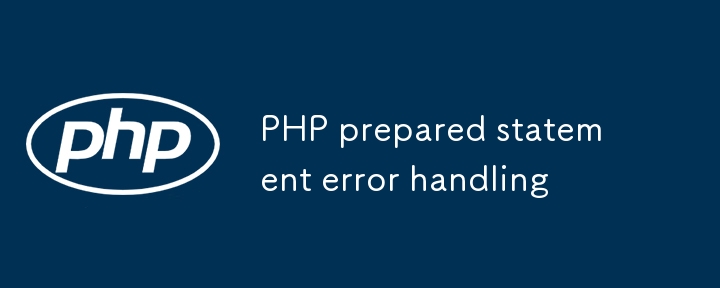Error handling is crucial in PHP preprocessing statements because it can improve program robustness and speed up troubleshooting. 1. Importance of error handling: Although preprocessing prevents SQL injection, execution failure may still occur due to SQL syntax errors, field name misspellings or connection interruptions. If unprocessed, it will be difficult to locate the problem. 2. PDO error handling: It is recommended to set PDO::ERRMODE_EXCEPTION to capture PDOException through try/catch and log logs to avoid exposing the original error information. 3. mysqli error check: You need to manually check whether each step is successful, and call $stmt->error or mysqli_error() to get the error details. 4. Common error response strategies include correcting SQL structure problems, ensuring parameter binding matches, and setting up retry or notification mechanisms for exceptions such as connection interruptions. 5. An error can be displayed in the development stage. After it is launched, logging should be turned off and logging should be used instead to ensure safety.

When using PHP's prepared statements, error handling is often easily ignored or not handled comprehensively. In fact, as long as you master a few key points, the program can be more robust and the problem detection will be faster.

Why is error handling important?
Preprocessing statements are an effective way to prevent SQL injection, but they do not mean that they will not go wrong. For example, SQL syntax errors, field name spelling errors, connection interruptions, etc. may cause execution failure. If error handling is not done, these errors may occur quietly, resulting in abnormal program behavior but difficult to locate the cause.
Both PDO and mysqli in PHP support preprocessing statements, but their error handling mechanisms are slightly different. You need to set the appropriate error reporting method based on the extension you are using.

Common practices when using PDO
If you are using PDO, it is recommended to set the error mode to exception ( PDO::ERRMODE_EXCEPTION ), so that exceptions can be directly thrown when an error occurs, which is convenient for centralized processing:
$pdo->setAttribute(PDO::ATTR_ERRMODE, PDO::ERRMODE_EXCEPTION);
After this configuration, any database operation errors will trigger PDOException , and you can capture and record detailed information through try/catch.

For example:
try {
$stmt = $pdo->prepare("SELECT * FROM users WHERE id = ?");
$stmt->execute([$id]);
return $stmt->fetch();
} catch (PDOException $e) {
// Record the log or return the error message error_log($e->getMessage());
echo "Database error, please try again later";
}Note: Do not expose the original error message to the user, which may leak sensitive data.
Error checking method in mysqli extension
For mysqli, it does not throw an exception by default like PDO. You need to manually check whether each step is successful and call $stmt->error or mysqli_error() to get the error message.
For example:
$stmt = $mysqli->prepare("INSERT INTO users (name, email) VALUES (?, ?)");
if (!$stmt) {
die("Prepare failed: " . $mysqli->error);
}
if (!$stmt->bind_param("ss", $name, $email)) {
die("Bind failed: " . $stmt->error);
}
if (!$stmt->execute()) {
die("Execution failed: " . $stmt->error);
}Although this method is a bit long-winded, it can give you control over every step and is suitable for scenarios with high stability requirements.
Common error types and coping strategies
- SQL syntax error : Usually occurs in the prepare phase, you can view specific information by printing
$stmt->erroror catching exceptions. - The field name is wrong or the table does not exist : it is a query structure problem, and the developer needs to correct SQL.
- Parameter binding mismatch : For example, if too many or too few parameters are passed, or the types are inconsistent, pay attention to the number and type of bind_param.
- Connection interrupt or timeout : There should be a global retry mechanism or notification mechanism for this type of error.
During the development stage, you can turn on the display error, but be sure to turn off or change to logging after it is launched to avoid exposing system details.
Basically that's it. The error handling of preprocessing statements is not complicated. The key is to develop the habit of checking whether it is successful after each database operation and record enough information for easy troubleshooting.
The above is the detailed content of PHP prepared statement error handling. For more information, please follow other related articles on the PHP Chinese website!

Hot AI Tools

Undress AI Tool
Undress images for free

Undresser.AI Undress
AI-powered app for creating realistic nude photos

AI Clothes Remover
Online AI tool for removing clothes from photos.

Clothoff.io
AI clothes remover

Video Face Swap
Swap faces in any video effortlessly with our completely free AI face swap tool!

Hot Article

Hot Tools

Notepad++7.3.1
Easy-to-use and free code editor

SublimeText3 Chinese version
Chinese version, very easy to use

Zend Studio 13.0.1
Powerful PHP integrated development environment

Dreamweaver CS6
Visual web development tools

SublimeText3 Mac version
God-level code editing software (SublimeText3)

Hot Topics
 What are some best practices for versioning a PHP-based API?
Jun 14, 2025 am 12:27 AM
What are some best practices for versioning a PHP-based API?
Jun 14, 2025 am 12:27 AM
ToversionaPHP-basedAPIeffectively,useURL-basedversioningforclarityandeaseofrouting,separateversionedcodetoavoidconflicts,deprecateoldversionswithclearcommunication,andconsidercustomheadersonlywhennecessary.StartbyplacingtheversionintheURL(e.g.,/api/v
 How do I implement authentication and authorization in PHP?
Jun 20, 2025 am 01:03 AM
How do I implement authentication and authorization in PHP?
Jun 20, 2025 am 01:03 AM
TosecurelyhandleauthenticationandauthorizationinPHP,followthesesteps:1.Alwayshashpasswordswithpassword_hash()andverifyusingpassword_verify(),usepreparedstatementstopreventSQLinjection,andstoreuserdatain$_SESSIONafterlogin.2.Implementrole-basedaccessc
 What are weak references (WeakMap) in PHP, and when might they be useful?
Jun 14, 2025 am 12:25 AM
What are weak references (WeakMap) in PHP, and when might they be useful?
Jun 14, 2025 am 12:25 AM
PHPdoesnothaveabuilt-inWeakMapbutoffersWeakReferenceforsimilarfunctionality.1.WeakReferenceallowsholdingreferenceswithoutpreventinggarbagecollection.2.Itisusefulforcaching,eventlisteners,andmetadatawithoutaffectingobjectlifecycles.3.YoucansimulateaWe
 What are the differences between procedural and object-oriented programming paradigms in PHP?
Jun 14, 2025 am 12:25 AM
What are the differences between procedural and object-oriented programming paradigms in PHP?
Jun 14, 2025 am 12:25 AM
Proceduralandobject-orientedprogramming(OOP)inPHPdiffersignificantlyinstructure,reusability,anddatahandling.1.Proceduralprogrammingusesfunctionsorganizedsequentially,suitableforsmallscripts.2.OOPorganizescodeintoclassesandobjects,modelingreal-worlden
 How can you handle file uploads securely in PHP?
Jun 19, 2025 am 01:05 AM
How can you handle file uploads securely in PHP?
Jun 19, 2025 am 01:05 AM
To safely handle file uploads in PHP, the core is to verify file types, rename files, and restrict permissions. 1. Use finfo_file() to check the real MIME type, and only specific types such as image/jpeg are allowed; 2. Use uniqid() to generate random file names and store them in non-Web root directory; 3. Limit file size through php.ini and HTML forms, and set directory permissions to 0755; 4. Use ClamAV to scan malware to enhance security. These steps effectively prevent security vulnerabilities and ensure that the file upload process is safe and reliable.
 What are the differences between == (loose comparison) and === (strict comparison) in PHP?
Jun 19, 2025 am 01:07 AM
What are the differences between == (loose comparison) and === (strict comparison) in PHP?
Jun 19, 2025 am 01:07 AM
In PHP, the main difference between == and == is the strictness of type checking. ==Type conversion will be performed before comparison, for example, 5=="5" returns true, and ===Request that the value and type are the same before true will be returned, for example, 5==="5" returns false. In usage scenarios, === is more secure and should be used first, and == is only used when type conversion is required.
 How can you interact with NoSQL databases (e.g., MongoDB, Redis) from PHP?
Jun 19, 2025 am 01:07 AM
How can you interact with NoSQL databases (e.g., MongoDB, Redis) from PHP?
Jun 19, 2025 am 01:07 AM
Yes, PHP can interact with NoSQL databases like MongoDB and Redis through specific extensions or libraries. First, use the MongoDBPHP driver (installed through PECL or Composer) to create client instances and operate databases and collections, supporting insertion, query, aggregation and other operations; second, use the Predis library or phpredis extension to connect to Redis, perform key-value settings and acquisitions, and recommend phpredis for high-performance scenarios, while Predis is convenient for rapid deployment; both are suitable for production environments and are well-documented.
 How do I perform arithmetic operations in PHP ( , -, *, /, %)?
Jun 19, 2025 pm 05:13 PM
How do I perform arithmetic operations in PHP ( , -, *, /, %)?
Jun 19, 2025 pm 05:13 PM
The methods of using basic mathematical operations in PHP are as follows: 1. Addition signs support integers and floating-point numbers, and can also be used for variables. String numbers will be automatically converted but not recommended to dependencies; 2. Subtraction signs use - signs, variables are the same, and type conversion is also applicable; 3. Multiplication signs use * signs, which are suitable for numbers and similar strings; 4. Division uses / signs, which need to avoid dividing by zero, and note that the result may be floating-point numbers; 5. Taking the modulus signs can be used to judge odd and even numbers, and when processing negative numbers, the remainder signs are consistent with the dividend. The key to using these operators correctly is to ensure that the data types are clear and the boundary situation is handled well.






